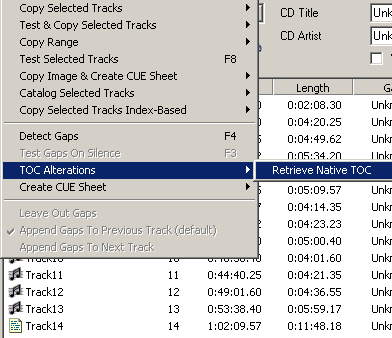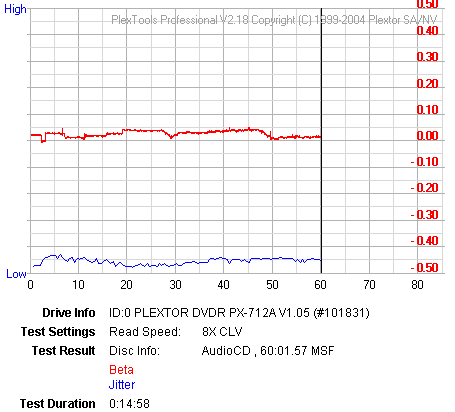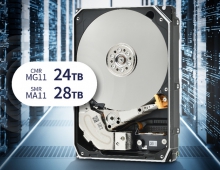Toshiba SD-R5372
7. Protected AudioCDs
Review Pages
2. Transfer Rate Reading Tests
3. CD Error Correction Tests
4. DVD Error Correction Tests
5. Protected Disc Tests
6. DAE Tests
7. Protected AudioCDs
8. CD Recording Tests
9. Writing Quality Tests - 3T Jitter Tests
10. Writing Quality Tests - Clover System Tests
11. DVD Recording Tests
12. CDSpeed/PlexTools Scans - Page 1
13. CDSpeed/PlexTools Scans - Page 2
14. CDSpeed/PlexTools Scans - Page 3
15. CDSpeed/PlexTools Scans - Page 4
16. CDSpeed/PlexTools Scans - Page 5
17. CDSpeed/PlexTools Scans - Page 6
18. CDSpeed/PlexTools Scans - Page 7
19. CDSpeed/PlexTools Scans - Page 8
20. CDSpeed/PlexTools Scans - Page 9
21. DVD+R DL - Page 1
22. DVD+R DL - Page 2
23. BookType Setting
24. Supported Media list
25. Conclusion
For this test procedure we used three audio discs with different audio copy protections. The ripping process on all protected Audio discs was carried out with Exact Audio Copy v0.9beta5.
The sample protected Audio discs were:
- Sony's Key2Audio from "Celine Dion - New Day Has Come"
- Cactus Data Shield 200 from "Natalie Imbruglia - White Lilies Island"
The Cactus Data Shield 200 disc contains artificial errors that are not easily bypassed by the reader, while the Key2Audio contains a second session, causing problems for readers when trying to read the Table Of Contents (TOC).
The tested tasks are:
- Recognition of the inserted disc (Yes/No).
- Ripping all wavs (with EAC's Burst Mode) to the hard disk with copy&compare function.
- Listening to the produced wavs for any click/skips.
The LG drive recognized up to the 12th Audio track of CDS200 disc,

and with the "Retrieve Native TOC" option removed, the 13th Data track was also recognized.

The test results are shown in the following table:
| Toshiba SD-R5372 |
Key2Audio |
CDS200 |
Cannot rip or read contents of the disc |
Ripping process too slow, while EAC reported timing problems on first track |
The drive failed to rip the contents of the Key2Audio protected disc, which it couldn't even recognize. The CDS200 protection scheme was easier for the drive but the ripping process was very slow and when reading the first track, there were many timing errors reported.
- Cactus Data Shield 200.0.4 - 3.0 build 16a (Aiko Katsukino - The Love Letter)
 This is a "special" CDS200 build, since it doesn't contain any artificial errors during the ripping process. Most problems occur when trying to write the ripped wav files, since the produced CD-R disc contains C2 and CU errors! This "problem" is rumored to be connected with specific chipset weaknesses.
This is a "special" CDS200 build, since it doesn't contain any artificial errors during the ripping process. Most problems occur when trying to write the ripped wav files, since the produced CD-R disc contains C2 and CU errors! This "problem" is rumored to be connected with specific chipset weaknesses.
We ripped the disc contents with EAC and burned the wav file produced from the Cactus Data Shield 200.0.4 - 3.0 build 16a disc with the latest Nero version as AudioCD+CD-Text. The burned media was checked for C1/C2 errors and for BETA/Jitter errors with PlexTools software using the Plextor PX-712A.
| Toshiba SD-R5372 | CDS 200.0.4 - 3.0 build 16a |
Ripping process too slow, while EAC reported timing problems on first track |
- C1C2 Error rate from PleXWriter PX-712A (8X CLV reading speed)

- BETA/Jitter Error rate from PleXWriter PX-712A

The C1 error levels are low while no C2 errors were reported.
We then tried to extract all wav files with the Plextor PX-712A and PlexTool DAE Error Correction 5th Level enabled:

No reading errors were reported after extracting all files.
Review Pages
2. Transfer Rate Reading Tests
3. CD Error Correction Tests
4. DVD Error Correction Tests
5. Protected Disc Tests
6. DAE Tests
7. Protected AudioCDs
8. CD Recording Tests
9. Writing Quality Tests - 3T Jitter Tests
10. Writing Quality Tests - Clover System Tests
11. DVD Recording Tests
12. CDSpeed/PlexTools Scans - Page 1
13. CDSpeed/PlexTools Scans - Page 2
14. CDSpeed/PlexTools Scans - Page 3
15. CDSpeed/PlexTools Scans - Page 4
16. CDSpeed/PlexTools Scans - Page 5
17. CDSpeed/PlexTools Scans - Page 6
18. CDSpeed/PlexTools Scans - Page 7
19. CDSpeed/PlexTools Scans - Page 8
20. CDSpeed/PlexTools Scans - Page 9
21. DVD+R DL - Page 1
22. DVD+R DL - Page 2
23. BookType Setting
24. Supported Media list
25. Conclusion





















